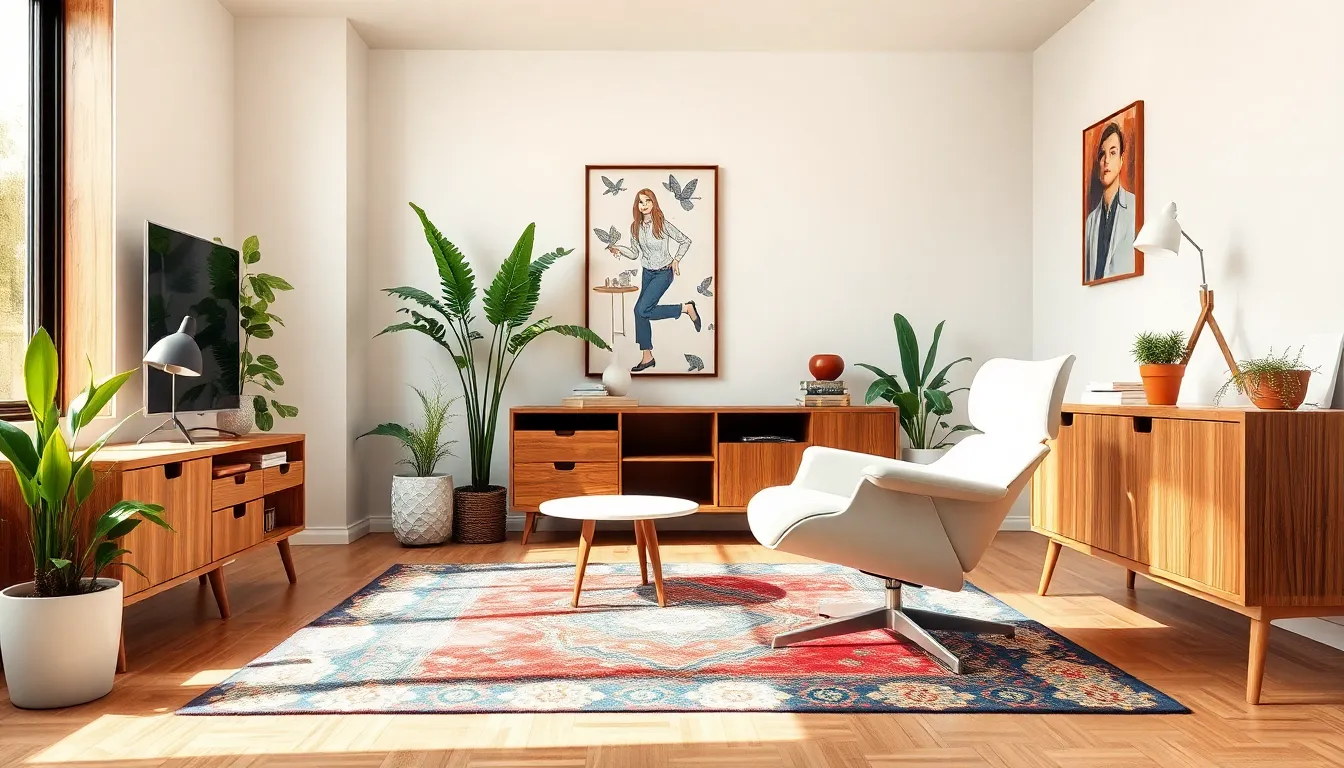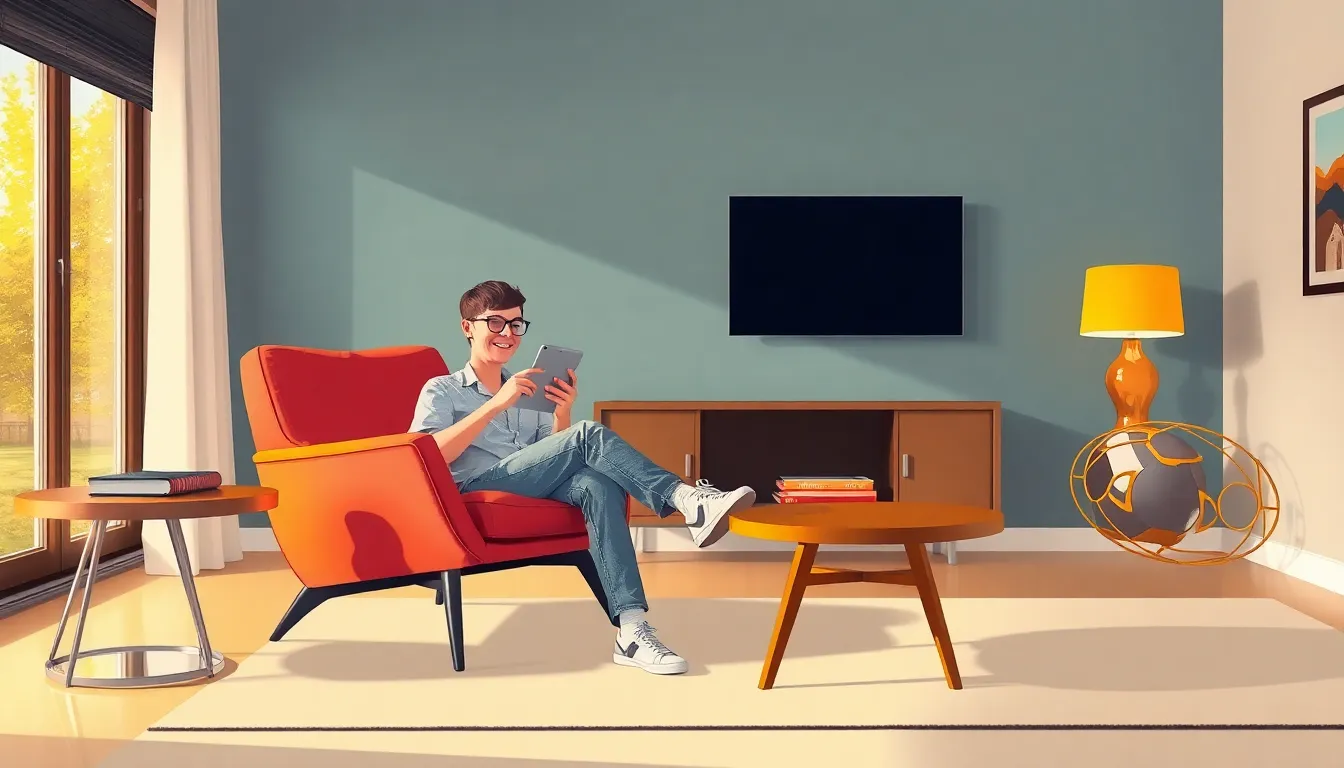In a world where trends come and go faster than a cat meme can go viral, vintage modern stands out like a classic rock anthem at a pop concert. This style effortlessly blends the charm of yesteryear with the sleekness of contemporary design, creating spaces that feel both nostalgic and fresh. Imagine lounging on a mid-century chair while scrolling through your favorite streaming service—it’s a time machine for your living room.
Table of Contents
ToggleUnderstanding Vintage Modern
Vintage modern design merges nostalgic elements from prior eras with contemporary aesthetics. This style effectively balances warmth and familiarity with a sleek, modern look.
Definition of Vintage Modern
Vintage modern refers to a design style characterized by the blend of vintage and modern features. This approach showcases the charm of classic pieces alongside newer elements. The juxtaposition creates environments that resonate with comfort and timelessness. Designers often select furniture from the mid-20th century and pair it with minimalist decor to achieve a harmonious look. Popularity for this style continues to grow, as it appeals to those who value both history and innovation.
Key Characteristics of Vintage Modern
Vintage modern exhibits several distinct characteristics. First, it prioritizes clean lines and functional forms typical of modern design. Second, vibrant colors from the past often dominate spaces, adding personality and warmth. Third, mixing materials such as wood, metal, and textiles enhances the visual interest in interiors. Fourth, vintage furniture pieces frequently serve as focal points, drawing attention while enhancing modern elements. Fifth, use of accessories, like retro lighting and artwork, adds depth and character to the overall aesthetic. This combination creates inviting spaces that feel both lived-in and contemporary.
The Evolution of Vintage Modern Design

Vintage modern design occupies a space where nostalgia and contemporary styles collide. This aesthetic embraces qualities from the past while integrating modern lines and functionality.
Historical Context
Vintage modern design originates from mid-20th century movements, particularly the post-World War II era. During this time, designers like Charles and Ray Eames popularized iconic pieces that still resonate today. The influence of minimalism and functionality emerged, offering simple yet striking designs. As the 1950s progressed, the fusion of different materials and textures became apparent. The design ethos prioritized everyday comfort alongside aesthetic appeal, targeting a wider audience. This period laid the groundwork for modern interpretations of vintage styles, marrying enduring qualities with current trends.
Influential Movements
Several movements significantly impacted vintage modern design. The Bauhaus movement emphasized simplicity and practicality, inspiring many designers to create functional furniture. Scandinavian design contributed natural materials, clean lines, and light aesthetics. Mid-century modernism, with its emphasis on organic shapes and bold colors, became particularly influential. Each movement introduced unique elements that continue to shape vintage modern aesthetics today. The harmony of design philosophies from these eras invites innovative interpretations that merge history with contemporary living. Adopting these diverse influences enhances the charm and offers comfort through thoughtfully crafted spaces.
Notable Vintage Modern Artists and Designers
Vintage modern design showcases many influential figures who shaped its identity. The movement blends past charm with contemporary appeal.
Pioneers of the Movement
Charles and Ray Eames defined mid-century modern design. Their iconic lounge chair remains an enduring symbol of comfort. Another key figure, George Nelson, introduced functional elegance with the Marshmallow sofa. Inspired by innovation, Eero Saarinen created the Tulip chair, emphasizing organic forms and smooth lines. Additionally, Arne Jacobsen contributed with the Egg chair, merging style and comfort seamlessly. These pioneers set the stage for a design movement that balances nostalgia and modernity.
Contemporary Practitioners
Current designers build on vintage modern principles while infusing fresh ideas. Jonathan Adler’s work exemplifies this trend, combining playful colors with classic shapes. Patricia Urquiola emphasizes versatility in furniture, blending different materials for unique textures. Similarly, Tom Dixon captivates with his industrial aesthetic, often mixing metals and vintage elements. Kelly Wearstler bridges old and new with her dynamic approach to materials. These contemporary practitioners successfully keep the vintage modern spirit alive, engaging a new generation of design enthusiasts.
Popular Vintage Modern Aesthetics
Vintage modern aesthetics thrive through a blend of nostalgic charm and contemporary style. Key elements contribute to creating inviting spaces that feel both familiar and fresh.
Furniture and Decor
Furniture pieces often serve as focal points in vintage modern design. Mid-century chairs, such as the Eames lounge chair, highlight seamless integration of comfort and style. Unique coffee tables and sideboards complement these timeless designs, enhancing overall aesthetics. Decorative accents, including retro lamps and artwork, add personality to spaces. Wall art featuring vintage prints often reflects historical influences, while geometric patterns enrich visual appeal. Combining these elements effectively creates a harmonious atmosphere that resonates with both history and modern living.
Color Palettes and Materials
Colors play a vital role in defining vintage modern aesthetics. Bold hues, such as mustard yellow, teal, and avocado green, evoke a sense of nostalgia. Earthy tones like terracotta and warm browns provide warmth and comfort. A balanced color scheme harmonizes with various materials like wood, metal, and fabric. Natural wood finishes accentuate vintage pieces while sleek metals incorporate a contemporary touch. Fabrics such as velvet and tweed add texture while connecting the past with present trends. This combination of vibrant palettes and diverse materials significantly enhances the visual and tactile experience of vintage modern spaces.
Vintage modern design stands as a testament to the beauty of blending the past with the present. Its unique ability to create inviting spaces resonates with those who appreciate both nostalgia and contemporary aesthetics. By incorporating iconic furniture pieces and vibrant color palettes, this style fosters an atmosphere of warmth and comfort.
As designers continue to innovate within this framework, vintage modern remains relevant and appealing. It invites individuals to embrace history while enjoying the conveniences of modern living. This design approach not only enhances interiors but also enriches the lives of those who inhabit them, making it a cherished choice for many.





